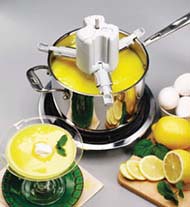Winter Soups with Tradition II - Gumbo
This is the second installment from my old Holiday Soups column, with a few revisions to bring it up to date: Gumbo, as zesty as you want to make it, as luxurious as you like. We associate gumbo with New Orleans and Louisiana, but it's popular throughout the southern states.
It's traditional on Christmas eve to go to Midnight mass, then come home to a simmering pot of gumbo. Sounds like heaven to me, especially up North where the winters are cold, cold, cold. After all the hardship that's been visited on that part of the country this past hurricane season, we should all cook a belated pot of gumbo to remind us of how important the recovery of the region is to our country, and maybe send them a little good luck for a change.
The first time I tasted gumbo was at the home of my friend, Lisa, in Hattiesburg, Mississippi. We were passing through on our way driving from Baltimore to San Francisco, in February, and she wanted to show us what southern hospitality was all about. She had some gumbo from the holidays in her freezer. She set it to thaw and simmer on the stove while she made a pot of rice. I don’t remember what all was in it, shrimp and chicken I know, but it really sang to me. So, I set off on a search for my own perfect gumbo.
The key to any gumbo is the roux. If you develop a real fondness for gumbo, you might want to make a large batch of roux to keep in the refrigerator to save time. It's best made in a cast iron dutch oven, the gumbo pot of choice for me. It needs to be a heavy bottomed pan to keep from scorching the roux. If you only have something lightweight, reduce the heat, watch it carefully, and never stop stirring.
This step can be time consuming, taking as long as an hour, but...here's where I insert a plug for about the handiest gadget I've ever come across. It's called a StirChef*, and it stirs sauces and other kinds of things that need constant attention, so you don't have to. Really. I use it for making this roux, allowing me more time to assemble and prep the other ingredients.
Filé powder also helps to flavor and thicken the mixture, as does okra, if you aren't put off by its texture. The variety of ingredients is limited only by your palate and you pocketbook. I’ve listed many, so just choose the ones you like, use them all, or add some of your own. If you can get crawfish and prefer them, use them instead of the shrimp. You can use whole chicken pieces and whole sausages, but they will require more cooking time.
Ingredients:
- 1 cup each Flour and vegetable oil
- 3-4 Onions, cut into segments, top to bottom
- 1 cup Celery, chopped
- 2 cups Red and green bell pepper, chopped
- 3 cups Turkey, pork or chicken, shredded
- 1 lb. Shrimp, peeled
- 1 lb. Sausage (Andouille or Linguiça), sliced
- 2 or 3 Bay leaves
- 10 cloves Garlic, diced finely
- 2 qts broth
- to taste Salt, white and cayenne peppers
- Optional: Sliced okra, chopped greens, chopped tomatoes
- File powder
- Hot long grain rice for serving
Instructions:
- Make the roux by combining the flour and vegetable oil in a heavy soup pot. Cook and stir over medium heat until the roux turns a caramel color, but not blackened. So, watch it carefully and stir continuously. Some people prefer a darker roux for spicier ingredients like the sausage. If that's you, continue cooking until the roux is a hazelnut brown.
- Sauté the onions, celery and sausage in a little vegetable oil until veggies are softened and sausage is lightly browned, and set aside. NOTE: If you're using whole chicken pieces, brown them here, as well.
- When the roux is colored, add the liquid in a stream, whisking as you add. If it's too thick, add more broth.**
- Add the remaining ingredients (minus "sea food") and let the gumbo simmer until the everything is cooked/heated through.
- Add the shrimp or crawfish. Simmer just long enough for them to cook.
- I pass the file powder at the table for those who like it. If you put it into the pot, do it at the end or it can get stringy and yucky.
Serving:
Put a mound of rice into a large soup bowl and spoon the gumbo over the top.
Provide hot sauce for those who can never get enough heat.
* A few years ago, I talked to the guy who developed the StirChef. I wondered how strong that motor could be, when it was run by just a few flashlight batteries - could it handle polenta/cornmeal, a very heavy dish? Well, they wanted to know how strong it was, too, so they tested it on cement. :G: Yeah, if it can handle cement, it can handle polenta. I have two of them. When I make my Polenta Florentine recipe, which requires both polenta and a bechamel sauce, I can have both of them cooking at once without having to worry about the stirring and the watching. Heaven.
** Alternatively, you can cook the bulky ingredients (meat and sausage) in the liquid ingredients first. Remove them, using a slotted spoon or tongs, and set aside. Then add the liquid to the roux.


0 Comments:
Post a Comment
<< Home